Finished Reading “The Real Wizard of Oz”
- Get link
- X
- Other Apps
What was the world like before “The Wizard of Oz”? Nobody reading this today has such a memory. If you do, your memory must be very good because each of us was introduced to Oz at a very young age. Rebecca Loncraine gives a masterful guided tour of the world in “The Real Wizard of Oz: The Life and Times of L. Frank Baum.” Loncraine’s carefully researched work shows us how far we are removed from the influences behind a story that always seems to have been.
The timeless story of “The Wizard of Oz” is the story of the world seen through a child’s eyes. It is a land discovered, not invented. While not an allegory, everything in Baum’s fantasy is intentional. He witnessed the world become fantastical. Work and play changed, along with imagination. Epidemics were widespread and the death rate was high. The mood was uncertain, mysterious.
A careful reader will discover that Baum’s imaginary world is not as far away as one might think. Baum’s personal story begins before the Civil War and ends at the start of the First World War. These were times when people believed in ghosts, marveled at circuses and side shows, were visited by circuit preachers and charlatans alike, and went to the theater to hear disembodied voices and sounds through a device called a telephone. Tornadoes moved houses, sending scarecrows dancing across the fields and into Baum’s dreams. The market for tin-made soldiers and toys grew while people still talked to their horses in the street. Baum witnessed the world brighten from candlestick to lightbulb. His visit to The White City at the Chicago World’s Fair glowed in his memory.
Loncraine traces the genius of Baum as a writer, publisher, playwright, photographer and salesman. From boyhood, on his own printing press, Baum wrote and published poems, jokes, reported news, and expressed opinion on anything from keeping the Sabbath to the tragedy of Wounded Knee. He published his own plays and created back-stories to children’s nursery rhymes. Did you know Baum is the first to publish his own “how to” journal on how to set up store display windows? His contribution to a writing competition gained public attention and stoked the fires of his already-kindled imagination. For a man born before the lightbulb, it’s interesting to note how many Oz books he made into film in the early 1900’s and the kinds of special effects that influenced film-making today. Baum’s genius was inherited by a young kid named Disney.
What does the world look like through the eyes of a child as written by a playwright-inventor plagued with dizzy spells? Baum showed us and everyone loved it. Everyone loved it so much, the story grew until at last, Dorothy has to send a special message to readers everywhere. Guaranteed, one will never encounter The Land of Oz the same way after reading Loncraine’s biography. Oz might be more real than imagined.
- Get link
- X
- Other Apps


